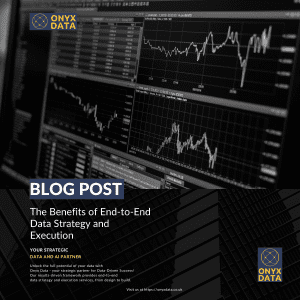
Today we live in a world where data is consumed and generated all around us. Organisations of all sizes and across all industries are recognising the importance of data as a strategic asset. However, many organisations struggle with managing and leveraging their data effectively.
This is where end-to-end data strategy and execution comes in.
An end-to-end data strategy and execution involves a comprehensive approach to managing data across the entire organisation, from collection and storage to analysis and decision-making. Here are some key benefits of implementing an end-to-end data strategy and execution:
Improved Data Quality
One of the primary benefits of an end-to-end data strategy and execution is improved data quality. By establishing standards and processes for data collection, storage, and management, organisations can ensure that their data is accurate, consistent, and up-to-date. This is essential for making informed business decisions and avoiding costly errors.
According to a study by Experian, poor data quality costs US businesses an average of $15 million per year. By implementing an end-to-end data strategy and execution, organisations can reduce the risk of data errors and save money in the long run. [^1]
Increased Efficiency
Another key benefit of an end-to-end data strategy and execution is increased efficiency. By streamlining data processes and reducing duplication of efforts, organisations can save time and resources. This can free up employees to focus on higher-value tasks, such as data analysis and decision-making.
According to a study by McKinsey, organisations that implement data automation and analytics can reduce their data processing time by up to 80%. This can lead to significant cost savings and improved business outcomes. [^2]
Better Decision-Making
With a comprehensive view of data across the organisation, decision-makers can make more informed and confident decisions. An end-to-end data strategy and execution can provide decision-makers with real-time access to data from multiple sources, allowing them to identify trends and patterns that might otherwise go unnoticed.
According to a study by MIT Sloan Management Review, organizations that use data and analytics to drive decision-making are twice as likely to be in the top quartile of financial performance within their industries. This highlights the importance of data-driven decision-making for long-term business success. [^3]
Enhanced Customer Experience
An end-to-end data strategy can help organisations better understand their customers and provide more personalized and targeted experiences. By collecting and analysing data on customer behavior and preferences, organizations can tailor their products and services to meet the needs of their customers.
According to a study by Salesforce, 84% of customers say that being treated like a person, not a number, is very important to winning their business. By leveraging data to provide personalised experiences, organisations can improve customer satisfaction and loyalty. [^4]
Improved Compliance
Finally, an end-to-end data strategy can help organisations better comply with regulations and avoid costly penalties. By ensuring that data is accurate and consistent, organisations can reduce the risk of non-compliance and demonstrate their commitment to data privacy and security.
According to a study by the Ponemon Institute, the average cost of a data breach is $3.86 million. By implementing an end-to-end data strategy and execution, organisations can reduce the risk of data breaches and avoid the associated costs and reputational damage. [^5]
In conclusion, an end-to-end data strategy and execution is essential for organisations that want to leverage their data as a strategic asset. By improving data quality, increasing efficiency, enabling better decision-making, enhancing the customer experience, and improving compliance, organisations can achieve long-term business success.
More information on data strategy can be found here.
References:
[^1] Experian. (2018). The True Cost of Bad Data. Retrieved from https://www.experian.com/assets/data-quality/white-papers/true-cost-of-bad-data.pdf
[^2] McKinsey. (2018). The Business Value of Data Automation. Retrieved from https://www.mckinsey.com/business-functions/mckinsey-analytics/our-insights/the-business-value-of-data-automation
[^3] MIT Sloan Management Review. (2017). The Analytics Mandate. Retrieved from https://sloanreview.mit.edu/projects/the-analytics-mandate/
[^4] Salesforce. (2018). State of the Connected Customer. Retrieved from https://www.salesforce.com/content/dam/web/en_us/www/documents/research-and-reports/state-of-the-connected-customer-report.pdf
[^5] Ponemon Institute. (2019). Cost of a Data Breach Report. Retrieved from https://www.ibm.com/security/data-breach/ponemon-cost-of-a-data-breach-report/






